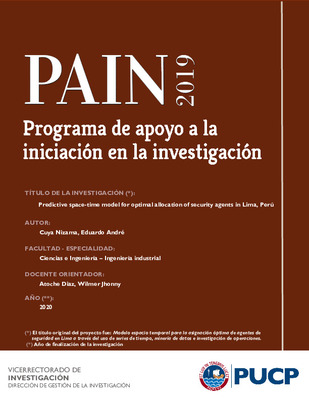Predictive space-time model for optimal allocation of security agents in Lima, Perú
Abstract
Nowadays, one of the most critical problems in Peru is crime and citizen insecurity. Part of this problem is due to a precarious assignment of security agents in geographic strategical zones at the right time. Furthermore, there is a lack of knowledge by the part of community members about certain existing patterns in crime. A large amount of data with geographic information, type of crime, time and other more meaningful variables is available to use. For this reason, the present research project is about a methodology using optimization models, machine learning and forecasting techniques to reduce these crime rates through the development of clusters that will allow us to identify the areas with the greatest confluence of crimes. A predictive spatial time model fed with data in real time will map the areas of high risk at a certain future point in the time. This model will be linked to an optimization model for assigning security agents to optimize and minimize the frequency of crimes and the existing citizen
insecurity


